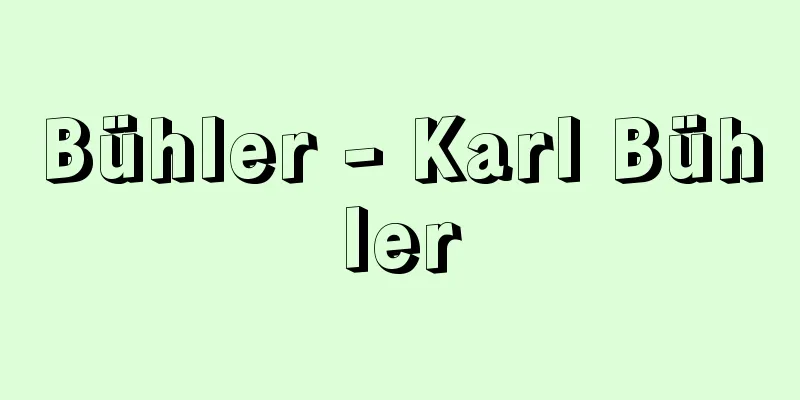Bühler - Karl Bühler

|
German psychologist. Born in Meckesheim, Baden. Influenced by the phenomenology of the philosopher Husserl. His early research was On Thinking (1907), which he conducted as a member of the Würzburg School. The method he used was called the "task method," in which subjects were asked to read works by Nietzsche and others, or given tasks to answer with "yes" or "no," and then asked about their experiences at the time. He argued that thinking does not require mental images, that blurred mental images do not make thinking ambiguous, that thinking is goal-oriented, creative, and aims to solve problems. Of course, W. Bunt opposed this, but in France, Binet claimed the priority of his own discovery (1903). In 1918, he wrote The Mental Development of the Child, proposing the concepts of developmental age and developmental index. During his time at the University of Vienna from 1922 to 1938, he influenced psycholinguistics with his works on language, such as Theory of Language (1934). In 1938, he was persecuted by the Nazis because of his Jewish descent, and soon fled to the United States. His wife, Charlotte Bühler (1893-1974), also a psychologist, specialized in developmental psychology and was famous for her research on neonatal behavior, social development, and adolescent psychology. In her later years in the United States, she was active in the field of clinical psychology. [Utsugi Tamotsu] "The Mental Development of Infants, translated by Shigeru Harada (1966, Kyodo Publishing)" "Language Theory, Vol. 1 and 2, translated by Yutaka Wakisaka et al. (1983, 1985, Chronos)" [References] | | | |Source: Shogakukan Encyclopedia Nipponica About Encyclopedia Nipponica Information | Legend |
|
ドイツの心理学者。バーデン州のメッケスハイムに生まれる。哲学者フッサールの現象学の影響を受けた。初期の研究はウュルツブルク学派の一員として行った『思考について』(1907)である。彼が用いた方法は「課題法」といわれるもので、ニーチェなどの作品を読んで聞かせたり、「イエス」「ノー」で答えるような課題を与えたりして、そのときの経験をあとから被験者に尋ねるもの。思考には心像は必要でない、心像がぼやけても思考はあいまいにはならない、思考は目標指向的、創造的であり、課題の解決を目ざしている、というのが彼の主張である。これに対してW・ブントはもちろん反対したが、フランスではビネーが自分の発見の優先権を主張した(1903)。1918年には『児童の精神発達』を書き、発達年齢、発達指数の概念を提唱した。1922年から1938年までのウィーン大学時代には、『言語理論』(1934)など言語に関する著作により心理言語学に影響を与えた。1938年ユダヤ系のためナチスの迫害を受け、まもなくアメリカに亡命。同じく心理学者のシャルロッテ・ビューラーCharlotte Bühler(1893―1974)は彼の夫人で、おもに発達心理学を専攻し、新生児行動、社会的発達、青年心理学の研究で著名である。晩年、アメリカでは臨床心理学の分野で活躍した。 [宇津木保] 『原田茂訳『幼児の精神発達』(1966・協同出版)』▽『脇坂豊他訳『言語理論』上下(1983、1985・クロノス)』 [参照項目] | | | |出典 小学館 日本大百科全書(ニッポニカ)日本大百科全書(ニッポニカ)について 情報 | 凡例 |
Recommend
Osumi-so
...The first time this site was mentioned as a te...
Overall balance
The current account balance is the sum of the curr...
Gallipoli Bay - Gallipoliwan
…In the name of defending Britain, 400,000 young ...
Ruhr Coalfields - Ruhr Kohlenfeld
Germany's largest coalfield spreads across th...
Anyousho - Anyousho
1894‐1990 Chinese educator. Born in Bazhong County...
Daifusen - Daifusen
〘Noun〙 One of the styles of ancient documents. A d...
Saguntum
…It has a good harbor, and around 1960 the iron i...
Omi Province - Oumi no Kuni
One of the provinces along the Tosando road. Curr...
Potemkin, Grigorii Aleksandrovich
Born: September 24, 1739, Chijobo [Died] October 1...
Malathion
...A low-toxicity organophosphate insecticide dev...
Dutt, Rajani Palme
Born: June 19, 1896, Cambridge [Died] December 20,...
Carbon disulfide - Niryukatanso
CS 2 (76.14). It is naturally found in small amou...
Mutsure Island
An island in the southwest of Yamaguchi Prefectur...
Gobelin (legend) (English spelling) Gobelin
...An ugly, dwarf-like sprite. Said to live in fo...
Eleocharis mamillata (English spelling) Eleocharismamillata
…[Tetsuo Koyama]. … *Some of the terminology that...









